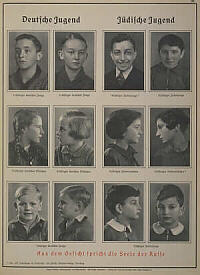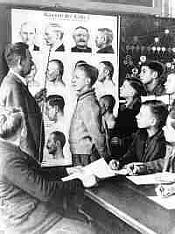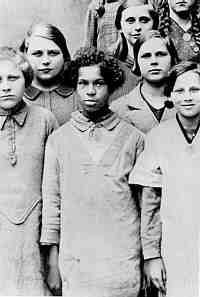|
|
|
|
Antisemitism and racism pervaded the Nazi world view. In speeches, Hitler emphasized racial purity and the superiority of the "Germanic race" -- the so-called Aryan master race. As part of the drive to "purify" and strengthen the German population, a 1933 law permitted physicians to perform forced sterilizations of psychiatric patients and congenitally handicapped persons, Roma (Gypsies), and Blacks.
|

 This photograph shows a classroom chart entitled “German Youth, Jewish Youth,”. It was published in a textbook on heredity, genealogy, and racial studies. —USHMM #14945/Alfred Vogel, Erblehre, Abstammungs, und Rassenkunde in bildlicher Darstellung (Stuttgart, 1938)
|
|

 This illustration from the Nazi magazine Neues Volk (New People), 1934, shows a German elementary school class in race hygiene. —USHMM Photo Archives #13394
|
|

 A slide for a lecture on genetics and race at the State Academy for Race and Health in Dresden shows the offspring of a German woman and an African colonial soldier stationed with French troops occupying the Rhineland after World War I. Some 500 teenagers--pejoratively called the “Rhineland bastards”--were forcibly sterilized after 1937 as part of Nazi policy to “purify” the German population. Ca. 1936. —USHMM #74845/Library of Congress
|
|
|
The Museum’s exhibitions are supported by the Lester Robbins and Sheila Johnson Robbins Traveling and Special Exhibitions Fund, established in 1990.
|
